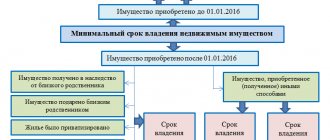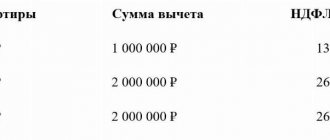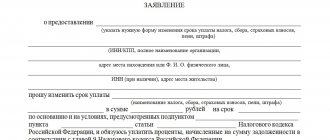If you have received income that is subject to declaration (for example, you sold an apartment or a car), then by April 30 of the next year you are required to submit a declaration to the tax authority, and by July 15 to pay the income tax calculated in the declaration (more details Deadline for filing the 3-NDFL declaration and payment of tax). A logical question is what will happen if you do not file a return on time or do not pay tax. In this article, we will take a closer look at the legal consequences of failure to file a return and failure to pay income taxes.
We will divide situations into three main groups and consider them separately:
- if you did not submit a return on time, according to which you do not have to pay tax (“zero” return);
- if you did not submit a return on time, as a result of which you had to pay tax;
- if you submitted your return on time, but did not pay the tax on time.
3-NDFL: Who should file
All income of individuals is subject to tax in Russia. Citizens who work for hire receive wages reduced by its amount. In this case, the calculation, deduction and transfer to the budget is carried out by the employer, who is the tax agent for personal income tax of his employees.
But it happens that an individual receives income independently. There is no tax agent for such income, so the responsibility for calculating and paying personal income tax falls on the citizen himself . For example, these are cases when an individual who does not carry out entrepreneurial activities:
- sold the property belonging to him;
- received income from its rental;
- received income under other civil law contracts (if the person who paid this income is not a tax agent for personal income tax);
- received expensive property as a gift from someone other than a close relative;
- otherwise independently received income subject to personal income tax.
A separate category of citizens are tax residents of the Russian Federation who received income outside the country in the reporting year. Please note that tax residents are persons who have lived in Russia for at least 183 days a year, while their sources of income are located abroad.
In all these cases, the citizen (tax resident) must independently pay tax on his income and report to the Federal Tax Service in Form 3-NDFL.
So, the first group of persons who submit the form in question are individuals (not individual entrepreneurs) who received income without a tax agent.
The second group are persons who are engaged in entrepreneurial activities , namely:
- individual entrepreneurs who apply the general taxation system;
- lawyers, notaries and some other persons engaged in private practice;
- heads of peasant farms.
The purpose of the 3-NDFL declaration is to inform the Federal Tax Service about the income of an individual. This is necessary to:
- tax authorities monitored the correctness of their personal income tax payment;
- a citizen could receive a tax deduction.
Concept and purpose
A declaration is a type of tax reporting, a document that contains data on the amount and methods of calculating a particular type of tax and is periodically submitted by individual groups of payers to the Federal Tax Service.
A special feature of a zero declaration is the fact that, in accordance with it, the amount of tax payable is zero.
This may be due to several reasons:
- lack of a tax base (in relation to land tax, this base is the cadastral value of a particular plot);
- a benefit used in calculations, according to which the base is reduced to zero (accordingly, the tax is also at zero);
- complete exemption of the payer from the need to pay (including in connection with existing benefits).
When submitting a zero declaration, the payer does not need to pay land tax , since its amount is 0. It is required only as documentary evidence for the Federal Tax Service that the absence of tax payments is legal and will not entail any penalties.
Submission rules
Declaration form
The current form 3-NDFL was approved by Order of the Federal Tax Service of Russia dated December 24, 2014 No. ММВ-7-11/ [email protected] . This is a multi-page form that consists of a title page, two sections and application sheets. Moreover, the annexes make up the majority of the declaration. They must be filled out depending on the availability of information. But all taxpayers must fill out the Title Page, Section 1 and Section 2.
Reporting deadlines
In general, 3-NDFL is submitted until April 30 of the following year . That is, income received by an individual in 2021 must be reported by April 30, 2021. This period applies to cases where the report is submitted for the purpose of declaring income. If an individual submits a form to receive deductions, then there are no deadlines - this can be done at any time.
Where and how to submit 3-NDFL
The form is submitted to the tax authority at the place of registration of the taxpayer , that is, at the place of residence of the individual. Standard delivery methods:
- to the territorial body of the Federal Tax Service in person;
- through a representative under a notarized power of attorney;
- by mail;
- in electronic form through the Federal Tax Service website or using online services.
Responsibility
Failure to pay personal income tax is punishable by a fine of 5% of the unpaid amount for each month of delay. Delay is counted from the day after the deadline for paying the tax. In this case, both full and partial months are considered.
If 3-NDFL is not filed , then the penalty depends on whether there is tax payable in it or not:
- if there is no tax, a fine of 1 thousand rubles will follow;
- if there is personal income tax to be paid, then the fine will be up to 30% of its amount.
Who does the filling?
According to the general rules established in Art. 398 of the Tax Code of the Russian Federation, only those entities that are its payers and belong to the category of legal entities must submit a land tax declaration.
Requirements and characteristics for payers are already established in Art. 388 of the Tax Code of the Russian Federation, according to which this subject is recognized as a legal or natural person who owns a land plot with certain rights. In particular, this should be the right:
- property;
- permanent unlimited use;
- lifelong inheritable ownership (this type of right applies only to citizen payers).
At the same time, certain categories of land or groups of payers are exempt from paying tax due to the provisions of the Tax Code of the Russian Federation. In particular, in Art. 389 of the Tax Code of the Russian Federation states that the following areas are excluded from the list of taxable lands:
- withdrawn from circulation;
- occupied by especially valuable objects of cultural heritage of the Russian Federation;
- from the forest fund lands;
- limited in circulation;
- occupied by water bodies from the water fund of the Russian Federation;
- included in the joint property of an apartment building;
- occupied by cultural and historical reserves, museum reserves.
Also, tax exemption is established by Art. 395 of the Tax Code of the Russian Federation in relation to the following types of organizations:
- penal system of the Ministry of Justice of the Russian Federation;
- religious (in relation to lands used for charitable or religious purposes);
- those who own land plots with state roads located on them;
- having at least 80% disabled people;
- who are residents of a special economic zone;
- shipbuilding (subject to the use of land for its intended purpose);
- included in the free economic zone.
Thus, in situations where the owner has a land plot, but it is excluded from the list of taxable objects, certain difficulties may arise with the preparation and submission of the declaration. In particular, it is logical to conclude that due to the absence of a taxable base and tax paid, the declaration should not be provided either.
However, there are precedents when the tax inspectorate initiates legal proceedings against companies that do not file zero returns, although they are legally exempt from paying the tax itself. And often the judicial authority satisfies their demands regarding the application of punishment to the payer for violating the deadlines for filing a declaration.
This is justified by the fact that the Tax Code does not contain a direct indication that land tax payers do not need to submit a zero declaration. Unlike, for example, property tax, for which a similar rule is established in Art. 373 Tax Code of the Russian Federation.
As a consequence of this, the application of punishment to a legal entity in such a situation may be completely justified and legal. Therefore, it is better for payers to still draw up and submit zero tax returns for land tax to the Federal Tax Service, while observing the rules established by law and the deadlines for filing this document.
Procedure for filling out 3-NDFL
General rules
The declaration form can be filled out:
- Manually . You must use blue or black ink. The fields are filled in from left to right from the outermost cell. Information must be indicated in printed characters according to the model from the Tax Service website. Dashes are placed in empty cells. Completely empty fields must also have a dash in each cell.
- On the computer . Text in form fields should be right aligned. The recommended font is Courier New, size 16-18.
Regardless of the filling method, you must adhere to the following rules:
- if there are not enough pages in a section, you need to use additional ones;
- all amounts, except tax, are indicated in kopecks;
- the tax amount is rounded according to standard rules (up to 50 kopecks is discarded, 50 kopecks and more are rounded to the nearest ruble);
- if the declaration reflects income received in foreign currency, it should be converted into rubles at the exchange rate of the Central Bank of the Russian Federation on the date of receipt;
- pages of the form should be numbered in a special “Page” field, with the number “001” assigned to the title page;
- it is necessary to attach documents (copies) confirming the information reflected in the declaration (they can also be listed in a separate list in any form);
- the title page indicates the number of sheets of the declaration and the number of additional (supporting) documents.
Filling out the title page
The topmost line of the title page, as well as all other sheets in the declaration, is intended for the TIN. Next is the page number. The following line is filled in:
- Correction number . When submitting the initial declaration, a “0” is entered; when submitting a second declaration, the serial number of the adjustment is indicated.
- Taxable period . The tax period code “34” corresponding to the year is indicated. Codes for other periods: 21 - I quarter, 31 - half a year, 33 - 9 months.
- Reporting period . The corresponding year is indicated - 2021.
- Code of the tax authority to which the declaration is submitted. This is a four-digit code, the first two digits of which correspond to the region code, and the last two digits correspond to the tax office code.
» data-medium-file=»https://kontursverka.ru/wp-content/uploads/2018/02/3NDFL-212×300.jpg» data-large-file=»https://kontursverka.ru/wp -content/uploads/2018/02/3NDFL-724×1024.jpg" loading="lazy" class="wp-image-5519 size-full" title="Filling out the title page" src="https://kontursverka. ru/wp-content/uploads/2018/02/3NDFL.jpg" alt="Form 3-NDFL, title" width="1654″ height="2339″ srcset="https://kontursverka.ru/wp-content /uploads/2018/02/3NDFL.jpg 1448w, https://kontursverka.ru/wp-content/uploads/2018/02/3NDFL-212×300.jpg 212w, https://kontursverka.ru/wp-content /uploads/2018/02/3NDFL-768×1086.jpg 768w, https://kontursverka.ru/wp-content/uploads/2018/02/3NDFL-724×1024.jpg 724w" sizes="(max-width : 1654px) 100vw, 1654px" /> Title page of the 3-NDFL declaration
Next, fill in information about the taxpayer. In the “ Country code ” field for Russia the code “643” is entered. The next field “ Taxpayer Category Code ” is very important. The data for it is taken from Appendix 1 to the procedure for filling out the report from the mentioned Order of the Federal Tax Service. We have listed these codes in a table:








